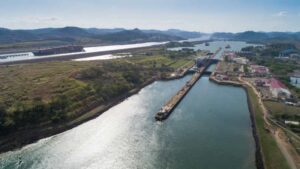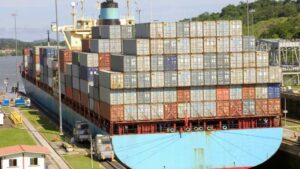(SQAUK) — The Panama Canal, which has been a major maritime route since it opened in 1914, has had a mixed impact on global trade. Mexico has faced economic challenges due to the canal’s control of regional maritime traffic. However, Mexico is preparing to build its own transoceanic railway, demonstrating resilience and strategic planning. This ambitious project not only challenges the dominance of the Panama Canal, but also has the potential to reshape naval trade in the Americas.
When the Panama Canal opened, it significantly shortened shipping routes, allowing vessels to bypass the lengthy and dangerous voyage around the southern tip of South America. However, this convenience came at a cost to neighboring countries like Mexico. The canal diverted much maritime traffic from Mexican ports, reducing their strategic importance and economic activity.

The change in trade routes led to decreased traffic at Mexican ports, causing substantial revenue losses. Instead of generating economic activity through docking fees, cargo handling, and related services, this activity shifted to Panama. This shift not only impacted port cities but also had a ripple effect on the overall economy, resulting in fewer job opportunities and hindered economic growth in regions relying on port activities.
The opening of the Panama Canal provided a quicker and more direct route for ships moving between the Atlantic and Pacific Oceans. This put Mexico at a disadvantage in the shipping and logistics industry. Mexican ports needed help attracting the same level of traffic as shipping companies preferred the efficiency and lower costs of using the Panama Canal. As a result, Mexico’s position as a maritime logistics hub in the region weakened.

In response to the challenges posed by the Panama Canal, Mexico is embarking on an ambitious project known as the Trans-Isthmus Corridor. This new project, traversing the Isthmus of Tehuantepec, aims to create a viable alternative to the Panama Canal. By enhancing Mexico’s role in global maritime trade, this project promises a more balanced and competitive international trade landscape.
Introducing a new railway corridor in Mexico will undoubtedly lead to competition with the Panama Canal. Shipping companies will now have an alternative route to consider, which could lead to lower transit fees and improved services as both canals compete for business. This competition also encourages innovation and efficiency improvements in maritime logistics.
The new Mexican corridor may decrease Panama’s revenue from canal tolls, as some maritime traffic is expected to shift there. This shift could require Panama to adjust economically and develop new strategies to maintain its financial stability and growth.

The potential success of Mexico’s Trans-Isthmus Corridor could also encourage greater regional cooperation. Central American countries should collaborate on infrastructure and trade initiatives, creating a more integrated and prosperous region.
Mexico’s plan to build its railway is a strategic move to counter the negative impacts of the Panama Canal and strengthen its position in global maritime trade. Despite facing various challenges, this ambitious project’s potential economic and regional benefits for Mexico are significant. As the Trans-Isthmus Corridor develops, it is poised to bring about a transformative shift in the dynamics of maritime trade in the Americas, ushering in a new era of competition and cooperation in the region.
Related video:


